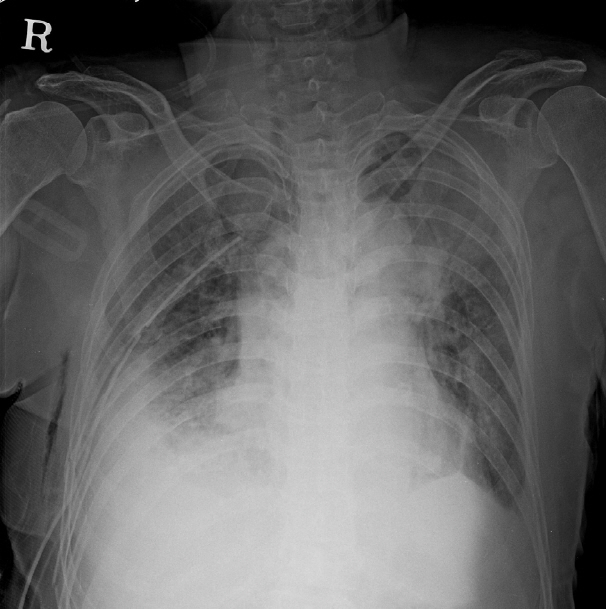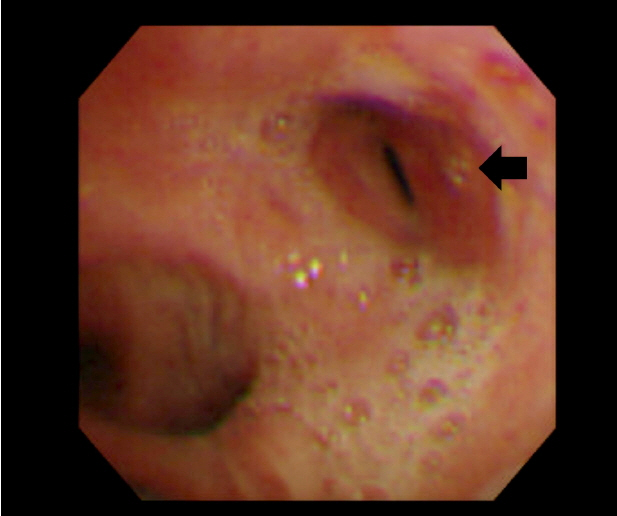Korean J Crit Care Med.
2014 Nov;29(4):344-347. 10.4266/kjccm.2014.29.4.344.
Lobar Bronchial Rupture with Persistent Atelectasis after Blunt Trauma
- Affiliations
-
- 1Department of Anesthesiology and Pain Medicine, Inje University Ilsan Paik Hospital, Goyang, Korea.
- 2Inje University Seoul Paik Hospital, Seoul, Korea. kkyungwoo@naver.com
- KMID: 2227745
- DOI: http://doi.org/10.4266/kjccm.2014.29.4.344
Abstract
- Rupture limited to the lobar bronchus from blunt trauma is especially rare, and the symptoms are light so diagnosis is difficult. In a patient who visited the hospital complaining of shortness of breath after falling down, atelectasis continued in the chest x-ray. Four days after visiting the hospital, a left upper lobar bronchial rupture was diagnosed through a bronchoscopy and 3 dimensional chest computerized tomography. When diagnosis is delayed in the case of a rupture limited to the lobar bronchus, bronchial obstruction can occur from the formation of granulation tissue, so regular monitoring is important. Therefore, when atelectasis continues after blunt trauma, it is important to differentially diagnose a lobar bronchial rupture through tests such as bronchoscopy.
Keyword
MeSH Terms
Figure
Reference
-
References
1). Seuvre M. Crushing injury from the wheel of an omnibus: rupture of right bronchus. Bull Soc Anat Paris. 1873; 48:680.2). Kiser AC, O'Brien SM, Detterbeck FC. Blunt tracheobronchial injuries: treatment and outcomes. Ann Thorac Surg. 2001; 71:2059–65.
Article3). Bertelsen S, Howitz P. Injuries of trachea and bronchi. Thorax. 1972; 27:188–94.4). Karmy-Jones R, Wood DE. Traumatic injury to the trachea and bronchus. Thorac Surg Clin. 2007; 17:35–46.
Article5). Symbas PN, Justicz AG, Ricketts RR. Rupture of the airways from blunt trauma: treatment of complex injuries. Ann Thorac Surg. 1992; 54:177–83.
Article6). Kirsh MM, Orringer MB, Behrendt DM, Sloan H. Management of tracheobronchial disruption secondary to nonpenetrating trauma. Ann Thorac Surg. 1976; 22:93–101.
Article7). Amauchi W, Birolini D, Branco PD, de Oliveira MR. Injuries to the tracheobronchial tree in closed trauma. Thorax. 1983; 38:923–8.
Article8). Chung HS, Lee JH. Bronchoscopic assessment of the evolution of endobronchial tuberculosis. Chest. 2000; 117:385–92.
Article9). Ayed AK, Al-Shawaf E. Diagnosis and treatment of traumatic intrathoracic major bronchial disruption. Injury. 2004; 35:494–9.
Article10). Taskinen SO, Salo JA, Halttunen PE, Sovijäarvi AR. Tracheobronchial rupture due to blunt chest trauma: a follow-up study. Ann Thorac Surg. 1989; 48:846–9.
Article11). Prokakis C, Koletsis EN, Dedeilias P, Fligou F, Filos K, Dougenis D. Airway trauma: a review on epidemiology, mechanisms of injury, diagnosis and treatment. J Cardiothorac Surg. 2014; 9:117.
Article12). Kirsner KM, Sarkiss M, Brydges GJ. Treatment of tracheal and bronchial tumors and tracheal and bronchial stent placement. AANA J. 2010; 78:413–9.13). Liu YH, Wu YC, Hsieh MJ, Ko PJ. Straight bronchial stent placement across the right upper lobe bronchus: a simple alternative for the management of airway obstruction around the carina and right main bronchus. J Thorac Cardiovasc Surg. 2011; 141:303–5.
Article14). Glazer ES, Meyerson SL. Delayed presentation and treatment of tracheobronchial injuries due to blunt trauma. J Surg Educ. 2008; 65:302–8.
Article
- Full Text Links
- Actions
-
Cited
- CITED
-
- Close
- Share
- Similar articles
-
- Bronchial Ruptures after Blunt Trauma in Two Patients: Different Time of Diagnosis and Different Prognosis
- A Case of Chest Traumatic Bronchial Rupture, Manifested by Bronchial Web in Bronchoscopy
- A CASE OF BRONCHIAL RUPTURE CAUSED BY BLUNT TRAUMA
- A Case of Neobladder Rupture Following Blunt Trauma
- Bronchial Rupture Following Blunt Chest Trauma: 3 cases reports





